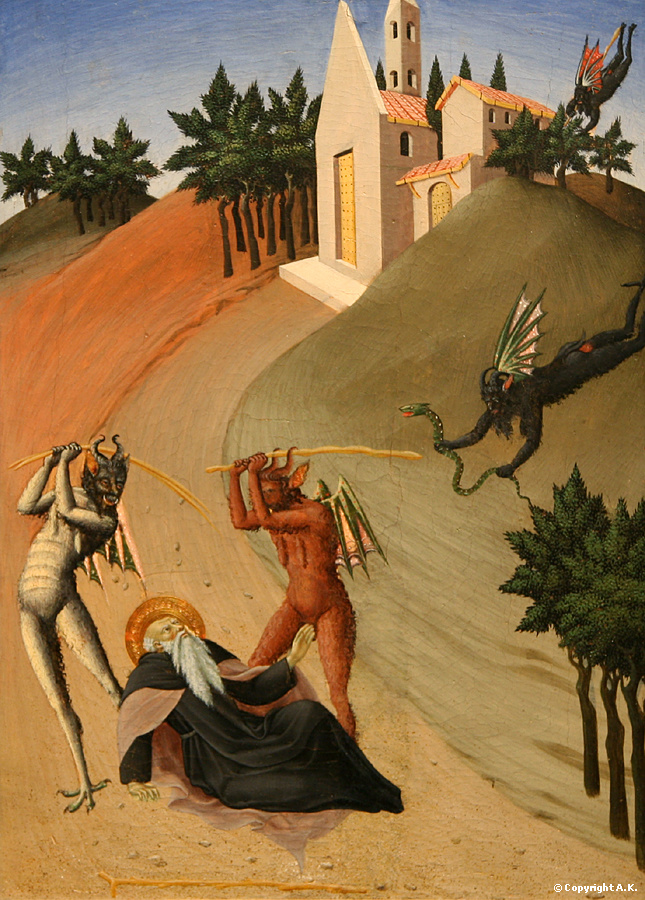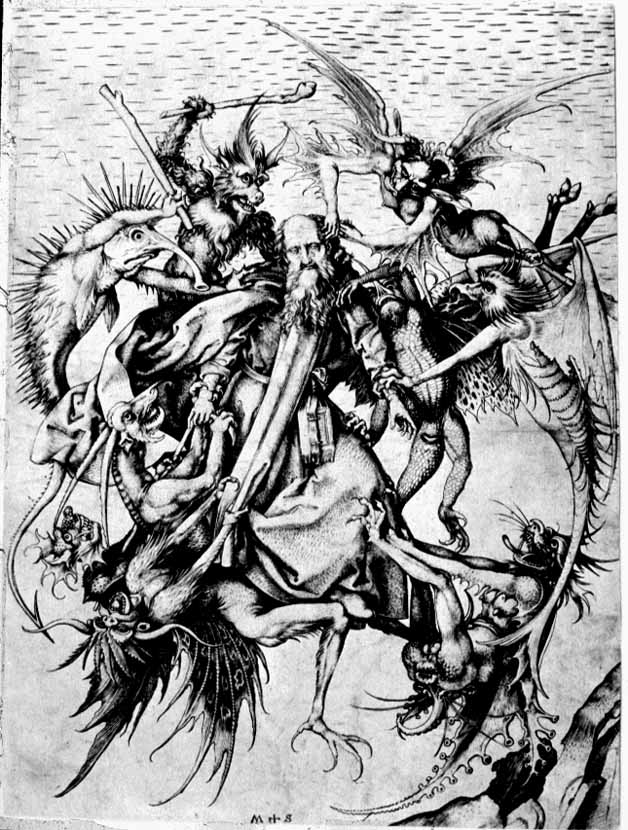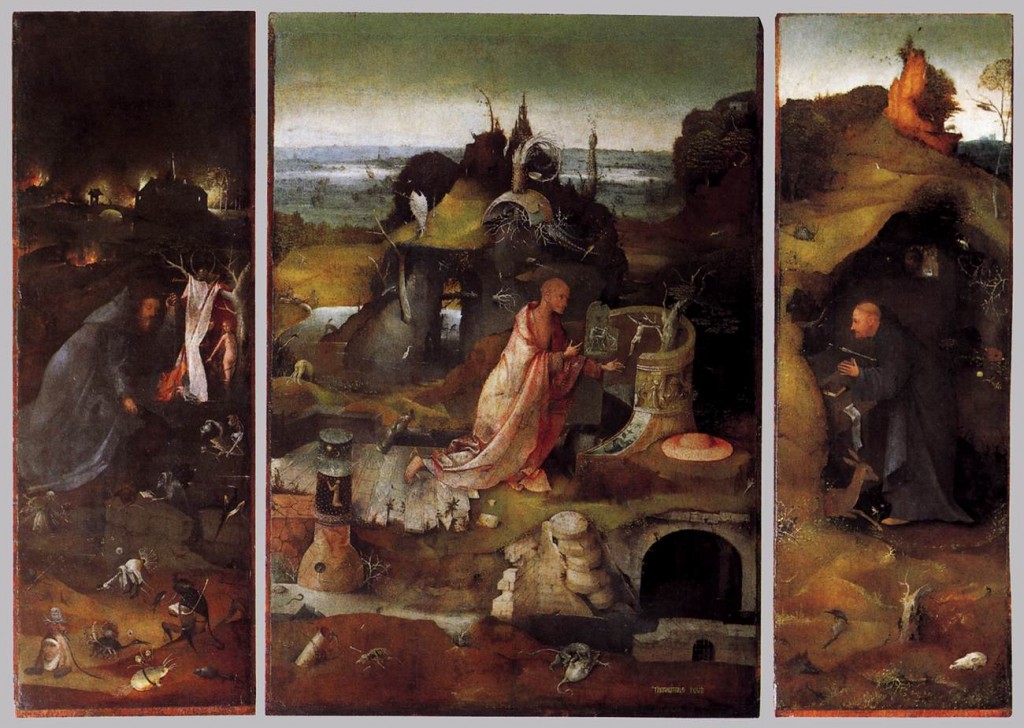The Thebaid, a fourteenth-century painting attributed to Gherardo Starnina depicts the Egyptian desert around Thebes as teeming with anchorites. The body of Saint Paul, the first Christian hermit and a contemporary of Saint Anthony , is shown in repose at far left, surrounded by mourners. The monk whose cart is pulled by a team of lions, seen to the left of the monastery garden may be Saint Jerome or Saint Anthony on his way to bury Saint Paul. To the right of center a beautiful girl has attempted to seduce a hermit who sits in front of one of the topmost huts; unsuccessful, she flees, unsheathing the demonic claws that reveal her true origin. :

Read More:http://www.independent.co.uk/arts-entertainment/art/great-works/starnina-gherardo-attrib-thebaid-1410-934885.html ---Lubbock:A pious viewer could have singled out the various stories for attention. And a proper account of this painting would itemise these details and try to identify them, producing a numbered key to the whole scene. But what a modern viewer sees in this Thebaid, and delights in, is something else. You could love the picture without knowing anything about the particular legends, or understanding what its strange title means. What it offers to us is a vision of the world. For a start, there is the sheer wideness of the image. It is actually about twice as wide as it's shown here. Much of the view has been cropped, at the left and the right – if not, the picture would just be a narrow strip across the top of the page.
Tom Lubbock:There’s a great feeling of simultaneity, of lots of different things happening at once. There is solitary activity, there are encounters, there are journeys by land and water, there is ritual. These things are all going on independently. But again, because they are evenly distributed across the landscape, and not very widely separated, there’s a sense of interaction and coordination among them, too. They’re like the pieces of a board game, going through their moves around a predetermined sequence of stopping points.
All this adds up to a vision – a vision of human life on Earth. We see an overview of the surface of the world. A multitude of people and actions are shown in a state of equality. In their lives there’s both diversity and pattern, independence and co-operation. Numerous individuals are proceeding on their individual paths, but also acting together, in mutually adjusting and non-conflicting ways. Starnina’s Thebaid presents an economy or ecology at work. You can see it as an early Renaissance version of one of those “symphony of a city” films, or a metaphor for a biosystem, or for any kind of undesigned, non-hierarchical, self-sustaining order. That’s its joy. Read More:http://www.independent.co.uk/arts-entertainment/art/great-works/starnina-gherardo-attrib-thebaid-1410-934885.html

Read More:http://www.terminartors.com/artworkprofile/Sano_di_Pietro-Saint_Anthony_Abbot_Tormented_by_Demons ---One of the eight panels in the Saint Anthony series (see 1871.57), this scene was painted not by the still-anonymous artist conventionally known as the Master of the Osservanza but by Sano di Pietro, with whom the Osservanza Master seems to have shared a studio for some period between 1428 and 1444. In this panel, Sano shows Saint Anthony Abbot physically beaten by demons. The next morning a companion will find him and bring him to the monastery seen in the background of the painting.---
…Has rationality ever at any time or place, had the hand over irrational beliefs and feelings and behavior? Just a quick glance at the present conflicts in the world would echo Edward Gibbon’s assertions on the decline and fall of Greco-Roman rationality, succumbing as it did in Gibbon’s view to the triumph of barbarism and religion.
In the late Greco-Roman world one of the dramatic signs of collapse was the withdrawal from society of individuals who found that society dissatisfying and disgusting. The earliest Christian withdrawers or anchorites were Egyptians who withdrew from the thickly populated Nile valley into the adjoining desert. There were other Christian ascetics who withdrew vertically instead of horizontally. Stylites, or pillar men, perched, for years on end, on the tops of columns. These withdrawals for the purpose of practicing extreme self-mortification, spiritual and mental, seemed to Gibbon to be distastefully irrational. There response, eccentric or not, has to be seen as a response to the moral failure of the world of Pericles and Aristotle.

Read More:http://www.usc.edu/schools/annenberg/asc/projects/comm544/library/images/006.html---Artist: Martin Schongauer Artist's Lifespan: 1430-1491 Title: St. Anthony Tormented by the Demons Date: c. 1480-1490 Location of Origin: Germany Medium: Engraving Original Size: approx. 13 x 11 in Style: Northern Renaissance Genre: Saints
The prelude to Christian asceticism was a centuries-long series of disillusioning shocks: fratricidal wars, self-destruction, war between Rome and Carthage. In the Greek world, by Socrates time, human relationships had gone wrong conspicuously and painfully enough to claim a philosopher’s undivided attention. Socrates became a moral philosopher, but he remained a rationalist. Socrates believed that human wickedness was due to ignorance, and that if a human being saw the truth, he would do what was right; a belief that is contradicted by everyone’s daily experience of his neighbors’ behavior and his own.
ADDENDUM:
Contemplative groups and monasteries around the country report a growing number of people pursuing a life of solitude, contemplation, and prayer. The Raven’s Bread, a quarterly newsletter for hermits, surveyed 590 subscribers last May, most of them scattered around North America. Out of 122 who responded, 88 are currently living as hermits,

Bosch. Read More:http://viewfromthebow.blogspot.com/2010/12/hieronymus-bosch-in-venice.html ---A figure much discussed because of the strong emotional content, strangeness and inquietude of his paintings, Anthoniszoon Jeroen van Aken, who signed himself and became known as Bosch, comes from a family of Dutch painters and is distinguished by his fantastical works, created to illustrate the moral and religious concepts of his time. His fanciful imagination, not always easy to interpret, uses the medieval bestiary, and always at the heart of his paintings is humanity doomed to hell because of sin. Meditation on the lives of the saints and the Passion of Christ seem to be the only way to redeem mankind from universal sin.---
…According to the survey, these contemporary hermits include nuns and monks, priests, Buddhists, and Quakers. Some live alone in complete silence, and some live in cloisters with other hermits. Some take public vows before clergy, while others maintain absolute anonymity. “It seems to be a movement that’s larger than the containers in place to hold it,” says the Rev. Cynthia Bourgeault, an Anglican priest and a hermit with the Contemplative Society in Victoria, British Columbia.
What is today’s equivalent of finding inner peace in a cell in the Sahara Desert in the tradition of St. Anthony, the most famous of the Roman Catholic hermits? Each hermit has his or her own interpretation of the solitary life. But if modern society creates a ringing in the ears that leaves many craving solitude, today’s world also puts up barriers to that solitude. Whatever their spiritual feats, the modern hermit’s first accomplishment is simply finding a way to be alone…. Read More:http://www.csmonitor.com/2001/1206/p15s1-lire.html
———————————————–
Theodor Roszak ( 1969): It is not easy to question the thoroughly sensible, thoroughly well-intentioned, but nevertheless reductive humanism with which the technocracy surrounds itself without seeming to speak a dead and discredited language. Especially so if one admits&emdash; as I do (pace the doctrinaire eschatology of old and new left)&emdash; that it may well lie within the capability of the technocracy to utilize its industrial prowess, its social engineering, its sheer affluence, and its well-developed diversionary tactics, to reduce, in ways that most people will find perfectly acceptable, all the tensions born of disorganization, privation, and injustice which currently unsettle our lives. (Note that I do not say it will solve the problems; but rather, like adjustive psychotherapy, it will cunningly soothe the neurotic hurt.) The technocracy is not simply a power structure wielding vast material influence; it is the expression of a grand cultural imperative, a veritable mystique that is deeply endorsed by the populace. It is therefore a capacious sponge able to soak up prodigious quantities of discontent and agitation, often well before they look like anything but amusing eccentricities or uncalled-for aberrations. The question therefore arises: ”If the technocracy in its grand procession through history is indeed pursuing to the satisfaction of so many such universally ratified values as The Quest for Truth, The Conquest of Nature, The Abundant Society, The Creative Leisure, The Well-Adjusted Life, why not settle back and enjoy the trip?”
The answer is, I guess, that I find myself unable to see anything at the end of the road we are following with such self-assured momentum but Samuel Beckett’s two sad tramps forever waiting under that wilted tree for their lives to begin. Except that I think the tree isn’t even going to be real, but a plastic counterfeit. In fact, even the tramps may turn out to be automatons . . . though of course there will be great, programmed grins on their faces. Read More:http://www.uni-lueneburg.de/import_export/1_11/1_11_34_1.html





 COMMENTS
COMMENTS